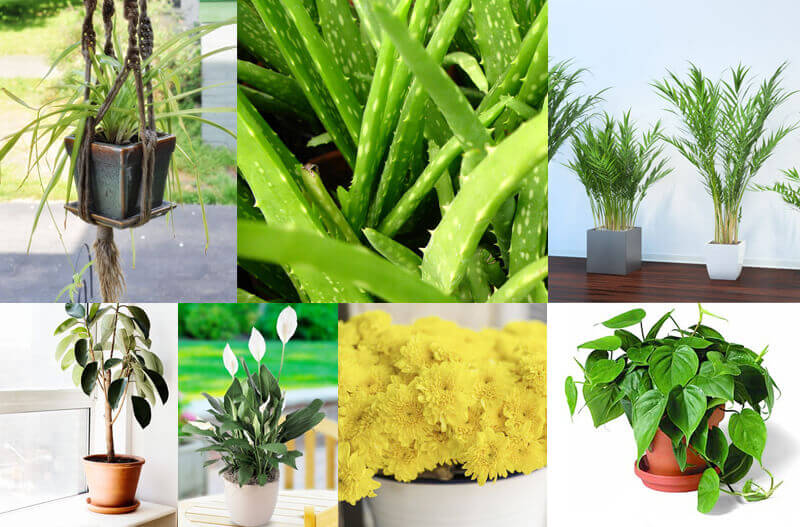The NASA Clean Air Study was a project initiated and led by the National Aeronautics and Space Administration(NASA) in alliance with the Associated Landscape Contractors of America (ALCA) to research ways to clean the air in space stations and they began studying houseplants with the meaning of providing clean and pure air for the space stations in the late ’80s and they also learned that there are many different indoor plants to help clean air on the earth as well.
According to the NASA Clean Air Study, there are plenty of plants that filter out some common volatile organic compounds (VOCs) in the air and make it much healthier to breathe, a bonus point is that we can keep a few of indoor plants to help clean air in our homes and they are not very tough to maintain.
Besides the air quality, plants also can make you feel positive and cheery, for example, there are a lot of hospitals that place plants in the patient’s room to make them feel more positive and it resulted in lower stress levels and blood pressure. Similarly, indoor plants may help people to be smarter by allowing them to stay alert and reducing mental fatigue.
Aloe Vera – Medicine Plant
Check all the details of this plant here!
As we all know, Aloe Vera has some great medicine properties for our skin and hair, but do you know that it is also known to remove formaldehyde (Formaldehyde is a colorless, strong-smelling gas used in making building materials and many household products) from the air. Aloe Vera plant is from succulent species of the genus Aloe and it can grow in indirect sunlight, bright light, or artificial light.
Areca Palm –
Check all the details of this plant here!
Areca Palm is a healthy disease-free plant and topped the NASA clean air study of the 10 best air purifying plants. Like all other palms, areca palm also grows well in filtered light, so the southeast or west-facing windows should be your first choice of placement. This plant specifically targets and removes benzene, formaldehyde, and carbon monoxide, which is really helpful if someone in your household smokes cigarettes.

Bamboo Palm
Bamboo Palm is a good-looking and soothing plant; it can significantly increase the beauty of any corner in your house. The bamboo palm also made NASA clean air study list of top-ten clean air plants with great purifying abilities. This plant would do well in indirect sunlight and would need extra care when it comes to watering.

English Ivy
English Ivy is the number one choice in houseplants that are easy to grow indoors as per the NASA clean air study because of its amazing air filtering abilities. It is the most efficient plant when it comes to absorbing formaldehyde. English Ivy is an adaptable plant and would do great in moderate temperatures and medium sunlight.

Garden Mum
Garden Mum plant also is from the NASA clean air study list and this is an air-purifying champion, it can help to remove ammonia, formaldehyde, benzene, and xylene from indoor air. This plant is quite popular in nurseries and doesn’t burn a hole in your pocket. After the bloom, Garden Mum can be planted outside.

Peace Lily
This plant is comparatively small with the rest of the plants listed in this post. The peace lily is known for removing benzene, a known carcinogen, and a common household chemical. It’s also said to remove mold spores in the air, fight with the cleaners and solvents chemical and also remove acetone and formaldehyde. It needs plenty of water, less often and bright, indirect light. In short, it’s a easy to grow indoor plant.

Philodendron
Philodendron is the best types of indoor plant for removing higher concentrations formaldehyde. This plant needs to be kept away from children and pets because of its poisonous qualities. This plant prefers moderate water and some sunlight.

Rubber Tree
The rubber plant is from India, it’s an evergreen and is easy to grow indoor plant. If you can not pay so much attention to your indoor plants then this one is for you. It easily grows in cooler environments and low light. It’s a very powerful toxin eliminator and air purifier.

Snake Plant
The snake plant is also found by NASA clean air study to absorb toxins, such as formaldehyde, and nitrogen oxides. This plant can be kept in low light levels and can handle the irregular watering. It also releases oxygen during the night (while most plants do during the day).

Spider Plant
Spider plants are also one of the easiest indoor plants to grow easily, these can make a very great choice for beginners or forgetful owners like me. With lots of rich foliage and tiny white flowers, the spider plant fights with formaldehyde, benzene, carbon monoxide, and xylene. They prefer bright, indirect sunlight and lots of water while growing.

Numerous individuals appreciate living and working in developed green spaces and almost like having delightful plants around. In any case, is there more to it? Here are a few more commendable qualities of indoor plants or plants in general;
1. Indoor plants may help diminish feelings of anxiety
An investigation distributed in the Journal of Physiological Anthropology found that plants in your home or office can cause you to feel more good, calmed, and regular.
2. Genuine plants may hone your consideration
Apologies, plastic plants won’t assist you with breezing through your tests. In a little report including 23 members, scientists put understudies in a study hall with either a phony plant, a genuine one, a photo of a plant, or no plant by any stretch of the imagination.
Mind sweeps of the members indicated that the understudies who concentrated with genuine, live plants in the study hall were more mindful and preferable ready to pack over understudies in different gatherings.
3. Working with plants can be restorative
For individuals encountering the side effects of dysfunctional or lazy behavior, indoor plants can be very helpful. Scientists have utilized agricultural treatment to build sentiments of prosperity among individuals with despondency, nervousness, dementia, and different conditions.
Albeit agricultural treatment has been around for quite a long time, it has discovered an advanced articulation: Medical facilities in Manchester, England are currently “endorsing” pruned plants to patients with sorrow or uneasiness side effects.
4. Plants may assist you with recuperating from ailment quicker
Having the option to take a gander at plants and blossoms may speed your recuperation from a disease, injury, or medical procedure. A 2002 survey of the examination uncovered that individuals recovering from a few sorts of medical procedure required less agony medicine and had shorter clinic remains than individuals who weren’t taking a gander at greenery during their recuperation periods.
It’s critical to take note of that most exploration centers around plants and common landscape in emergency clinic settings as opposed to at home.
5. Plants may support your profitability
A bromeliad may end up being the best desk area mate you’ve ever had. Various investigations have discovered that plants in the workspace increment both efficiency and innovativeness. One often referred to concentrate from 1996 found that understudies in a grounds PC lab worked 12 percent quicker and were less pushed when plants were set close by.
In a recent report, specialists provoked individuals to make inventive word affiliations. They performed better when a plant was in the stay with them.
What’s more, one more report demonstrated that individuals with more plants in their workspace took fewer days off and were more productive at work.
6. Plants may improve your entire attitude toward work
A perspective on the city park may improve anybody’s activity fulfillment — yet it may shock you to discover that a pruned plant could have a comparable impact. Analysts met more than 440 Amazon workers in India and the United States. They found that those whose office conditions included regular components like indoor plants felt more noteworthy occupation fulfillment and more promise to the association than the individuals who didn’t work around characteristic components.
Specialists said the normal components assisted with buffering the impacts of occupation stress and nervousness.
Here are the top 10 indoor plants to help clean air from Nasa Clean Air Study, I hope you found it useful if yes then do share it with your friends and let me know which one is your fav in the comments section. Breath FRESH and CLEAN!

9 Smart Coffee Table Styling Tips To Adopt
Imagine you have a very great looking sofa, a beautiful featuring wall, and all the stuff to give your living room the best look you can but when it comes to the center table or coffee table you have no idea what to do about it or maybe you’re afraid you’ll make it look cluttered with some random items. These 9 Smart Coffee Table Styling Tips will surely help you to give a quick start. Read More




6 thoughts on “Nasa Clean Air Study – 10 Indoor Plants To Help Clean Air”